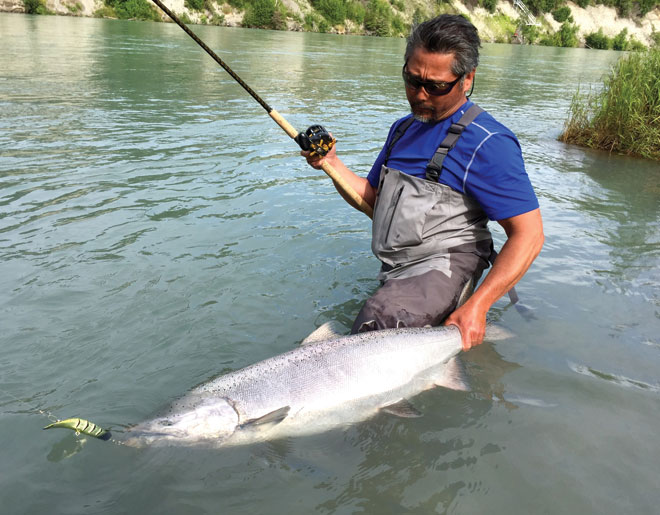
The author with a prime example of the egg wagons we should be releasing on the Kenai. Such hens produce more and bigger eggs, and can spawn in habitat that protects the embryos from flood and predation. © Coley Gentzel.
Kings on the Gravel
Blog by Francis V. Estalilla, MD
The brand new 48-pound platinum-bright four-ocean Kenai tidewater hen you just landed is a marvel to behold. Breathless with excitement, you’re awestruck not just by her size, but also her gleaming flanks, the pearlescence in her tail, and the bold, black spots splattered across her thick, metallic-purple-hued back. Despite long odds, she made it from egg to adulthood, surviving the assaults of a gravel-scouring flood; marauding trout and hungry mergansers patrolling the river; predatory sharks, pinnipeds, and orcas roaming the open ocean; menacing pollock trawlers in the Gulf of Alaska and Bering Sea; and deadly gillnets laid in her migratory path along Shelikof Strait and the eastside beaches of Cook Inlet to the mouth of the Kenai River. Her fate is now literally in your hands…the choice is entirely yours. And I’m here to tell you why releasing that mega-hen matters more than you can imagine.
Size is a huge competitive advantage. A big hen king can leverage its greater physical size to utilize prime spawning habitat otherwise unavailable or inaccessible to a smaller salmon. She can spawn in deeper, stronger main stem flows unsuitable for smaller fish. Eggs laid there are far less susceptible to the perils of de-watering during a future low-water event.
More body mass is also capable of moving larger cobble and digging a deeper redd, as much as three feet below grade. Eggs safely deposited deeper in the gravel are far less prone to the hazards of scour from future high-water events or from over-spawning by later-arriving species of salmon. They are also better protected from predatory trout.
Moreover, size has profound reproductive significance. ADF&G has shown that larger Kenai females statistically bear more and larger eggs. That begs repeating, folks. Not only do bigger hens produce more eggs, but bigger hens also produce bigger eggs. Why is that so important? Simply put, big eggs produce big, well-nourished fry. Larger juveniles, in turn, are more successful at foraging and evading predators, giving them a decided competitive edge to win the game of survival.
With horribly diminished Chinook productivity, isn’t every contributing factor worth considering? Especially the ones we have direct control over?
If recovery is to occur, the quality of Kenai kings on the gravel must trump the quantity of kings on the gravel. What good is an escapement that’s 80% males? Fewer hens means that much less seed available for potential productivity. Further, the current scarcity of big fish means each remaining hen is depositing even fewer eggs into the gravel. This is what biologists refer to as fecundity…the number of potential embryos an individual fish can produce. More critically, it’s the collective fecundity of the whole escapement that really counts. It’s not nearly as important how many kings make it to the spawning grounds, but rather how many viable embryos are physically deposited into the gravel each season. Big hens produce more viable embryos.
In the end, it’s all about the hens…and the collective payload in those egg wagons that ultimately escape the fishery. Keep in mind that the biggest hens are the ones best able to carry and successfully deposit their precious cargo to the most productive spawning gravel in the river. Also recognize that angler behavior has an undeniable effect on which fish escape the in-river fishery and which ones don’t.
Now let’s get back to that fish in your hands. She’s carrying upwards of 15,000 prime-quality eggs to produce the next generation of Kenai kings. When that choice is entirely up to you, remember that the gravel needs those eggs way more than your bait cooler does. Yeah, hens matter…but more importantly, BIG hens matter. Just let her go.
Francis V. Estalilla, MD has avidly fished the Kenai River since 1974. “Treading lighter on the resource” is a recurring theme in his published works.
This blog originally appeared as the Fish For The Future column in the March 2020 issue of Fish Alaska.


